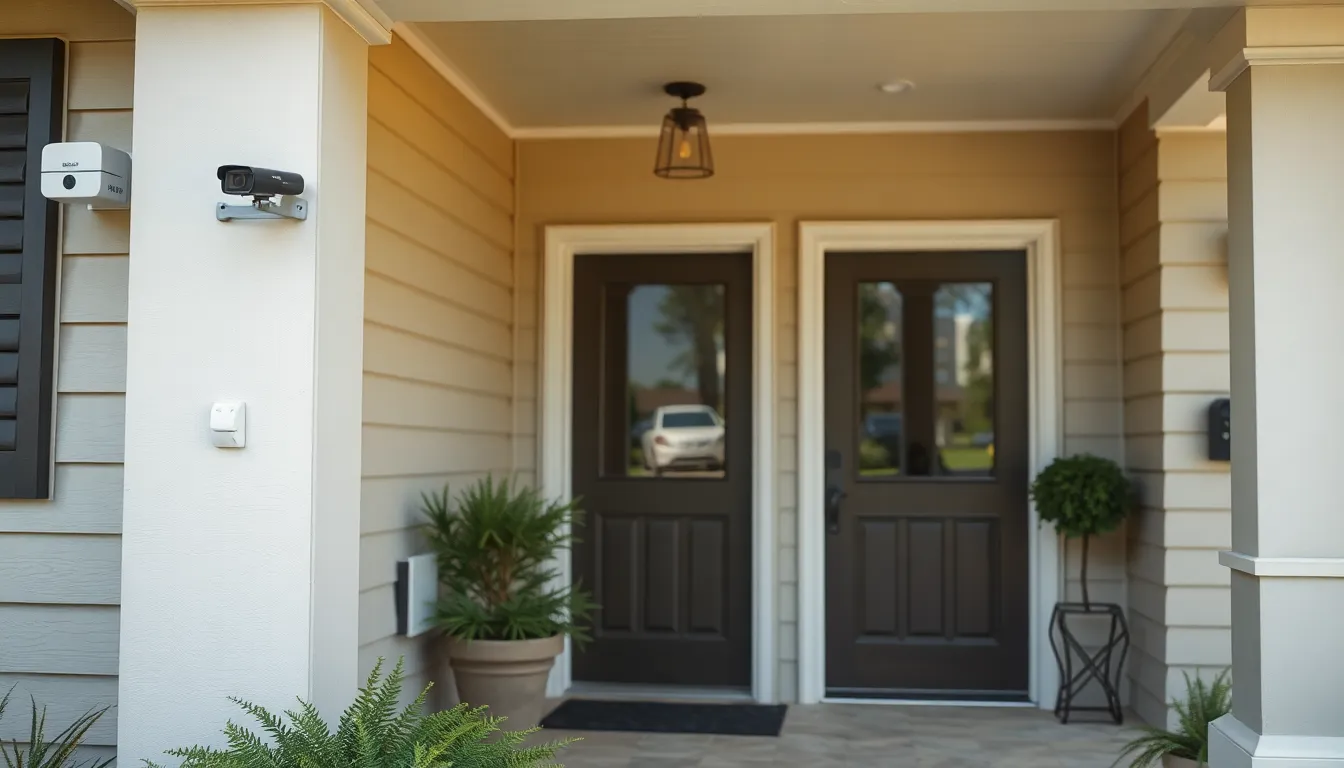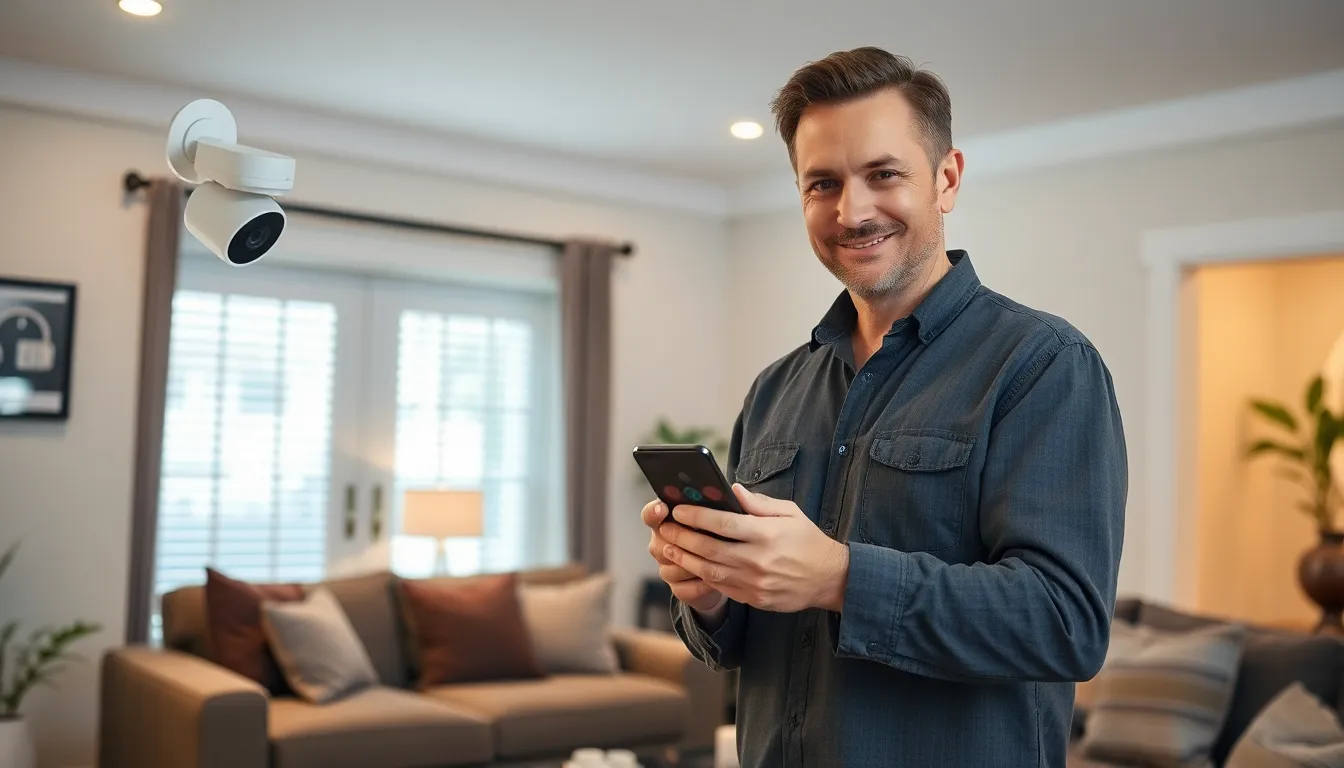In a world where even your toaster can be smarter than some of your neighbors, home security has taken a high-tech twist. Gone are the days of simple locks and neighborhood watch signs. Today’s smart home security systems not only guard your castle but also keep you connected, informed, and maybe even a little entertained.
Table of Contents
ToggleOverview of Smart Home Security
Smart home security systems integrate various technologies to provide comprehensive protection. These systems often include surveillance cameras, motion detectors, and smart door locks. Users can monitor their homes remotely, enhancing peace of mind.
Modern smart cameras offer features like night vision and high-definition video. They record footage, enabling quick review of any suspicious activity. Doorbell cameras enhance entry security by allowing users to see and communicate with visitors remotely.
Home automation plays a significant role in smart security. Smart lights can simulate occupancy by turning on and off at scheduled times. Sensors detect unusual movements, sending alerts to connected devices or smartphones.
Integrations with smart assistants further streamline operations. Voice commands control locks, alarms, and cameras seamlessly. These features enhance user-friendliness and accessibility.
Data security remains a critical consideration. Encryption and secure protocols safeguard user information from potential breaches. Regular software updates ensure that systems stay ahead of emerging threats.
Cost varies depending on features and system complexity. Basic systems may start around $200, while comprehensive setups can exceed $1,500. Subscription fees for cloud storage and professional monitoring often apply to higher-end systems.
Many users appreciate the convenience of integration with other smart home devices. Interconnected devices enhance overall security by providing multiple layers of protection. For instance, if a camera detects motion, it can trigger outdoor lights to illuminate the area.
The continued evolution of smart home security reflects changing needs. Homeowners increasingly prioritize safety and convenience, making these systems a growing trend in residential security.
Key Components of Smart Home Security

Smart home security relies on several crucial components to ensure effective protection. Each element works together, providing homeowners with peace of mind.
Security Cameras
Security cameras offer real-time monitoring for residential properties. Many models include features such as high-definition video and night vision, ensuring clarity in various lighting conditions. Users can access live feeds through smartphone apps, facilitating immediate responses to potential threats. Cloud storage options often enable easy retrieval of recorded footage. Increasingly, smart cameras integrate with other systems, enhancing overall security through seamless communication.
Smart Locks
Smart locks revolutionize the way homeowners secure their doors. Users can lock and unlock doors remotely using smartphones, making access more convenient for family and friends. Features often include keyless entry, allowing for temporary codes for guests or maintenance personnel. Notifications about door status keep users informed, ensuring enhanced security. Many smart locks also support voice commands through virtual assistants, enabling hands-free operation. Shifting to smart locks reduces reliance on traditional keys, bolstering access control.
Motion Sensors
Motion sensors significantly boost home security by detecting unusual activity. These devices alert users via connected systems, prompting immediate action if needed. Typically, motion sensors can distinguish between pets and humans, reducing false alarms. Installation in strategic locations provides coverage for entryways and vulnerable areas. Integrating motion sensors with cameras leads to more effective monitoring and response strategies. Many devices also connect to smart lighting systems, illuminating areas when motion is detected, further enhancing safety.
Benefits of Smart Home Security
Smart home security provides multiple advantages that resonate with modern homeowners, enhancing safety and convenience.
Convenience and Automation
Smart home systems automate security tasks, reducing the need for manual intervention. Users can control locks, cameras, and alarms from their smartphones, allowing easy access to home security features. Voice commands streamline operations, enabling seamless interaction with the system. Scheduling lights and alarms enhances home security by simulating occupancy when owners are away. This level of automation not only simplifies daily routines but also fosters a perception of heightened security through consistent monitoring.
Enhanced Monitoring and Alerts
Continuous monitoring is a significant benefit of smart home security. Advanced surveillance cameras offer real-time feeds available through mobile apps, providing instant access to home visuals. Motion detectors send immediate alerts for unusual activity, ensuring homeowners stay informed. Notifications delivered to smartphones allow for timely responses, whether from a neighbor, friend, or security service. The ability to review recorded footage adds an extra layer of assurance, enabling homeowners to address incidents swiftly.
Popular Smart Home Security Systems
Numerous smart home security systems exist today, each offering unique features. Their designs often cater to various user needs, including different price ranges and functionalities.
System Comparisons
Comparing popular smart home security systems reveals intriguing differences. Ring provides comprehensive video surveillance with easy app access, while Arlo offers wireless flexibility, making installation effortless. Nest Cam stands out with its intelligent alerts, ensuring users receive relevant notifications for specific activities. SimpliSafe combines affordability with professional monitoring options, appealing to budget-conscious consumers. Each system features distinctive strengths, empowering homeowners to choose based on their specific requirements and preferences.
User Reviews
User reviews highlight the practicality and effectiveness of these systems. Many customers praise Ring for its high-quality video feed and user-friendly mobile app. Arlo enjoys positive feedback for its integration with smart home devices and simple installation process. Nest Cam attracts users who value intelligent feedback, noting its efficient motion detection features. SimpliSafe garners appreciation for its affordability and no-contract monitoring options, making it ideal for renters. Overall, user satisfaction remains high across these systems, reflecting their reliability and ease of use.
Challenges and Considerations
Smart home security systems pose unique challenges and considerations for users. Privacy concerns remain paramount as these systems often require extensive data access.
Privacy Concerns
Privacy concerns arise due to the high volume of data smart home devices collect. Surveillance cameras can record video feeds from users’ properties, leading to potential misuse if accessed by unauthorized individuals. Data breaches and hacking threats add another layer of risk, as personal information may fall into the wrong hands. Ensuring robust encryption and secure storage practices is essential to mitigating these threats. Users must also stay informed about privacy policies implemented by manufacturers to understand how their data is managed and protected. Some companies offer transparency reports detailing their data handling processes, fostering user trust and confidence.
Integration Issues
Integration issues frequently challenge users adopting smart home security technology. Compatibility between devices from different manufacturers may create functionality problems. Not all devices communicate seamlessly, leading to potential gaps in security coverage. Establishing a unified platform that manages multiple devices efficiently is essential for maximizing security effectiveness. Some users face difficulties incorporating older devices with newer smart technology, complicating the upgrade process. Regular firmware updates can address some of these integration challenges, enhancing device compatibility and performance. Familiarizing oneself with the integration capabilities of selected devices plays a critical role in achieving a streamlined smart home security system.
Smart home security represents a significant advancement in protecting residential spaces. With the integration of various technologies homeowners can enjoy greater peace of mind knowing their properties are monitored and secured. The ability to control systems remotely and receive instant alerts enhances the overall user experience.
As the demand for convenience and safety grows smart home security systems are becoming essential. Homeowners can choose from a range of options that fit their needs and budgets while ensuring robust protection. By staying informed about privacy concerns and integration capabilities users can maximize the effectiveness of their smart security solutions. Embracing these systems not only safeguards homes but also aligns with modern living.




